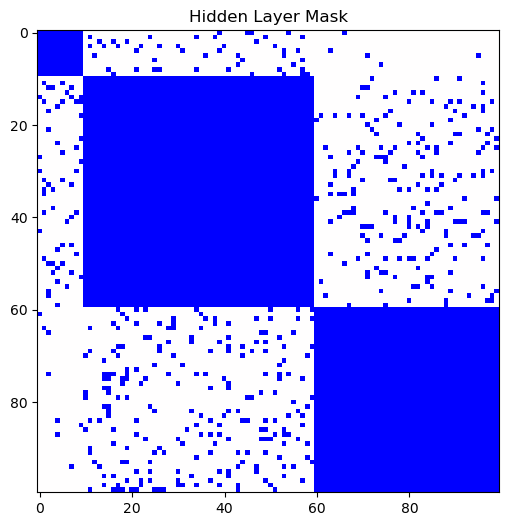Methods
mask.visualize( )
Description
Print out the generated masks.
Usage
The example below will create a MultiArea object with 3 areas. mask.visualize() is called to print out the generated masks.
area_connectivities = np.array([
[1.0, 0.1, 0.02],
[0.1, 1.0, 0.1],
[0.02, 0.1, 1.0]
])
n_areas = [10, 50, 40]
params = {
"n_areas": n_areas,
"area_connectivities": area_connectivities,
"hidden_size": 100,
"input_dim": 2,
"readout_dim": 2,
"input_areas": [0],
"readout_areas": [1],
}
multiarea = MultiArea(**params)
multiarea.visualize()
Output:



mask.get_masks( )
Description
Return layer masks in a list.
Returns
masks: (list) A list of masks. Each mask is a 2D numpy array.
Usage
import torch
from nn4n.mask import MultiArea
params = {
"hidden_size": 100,
"input_dim": 2,
"readout_dim": 2,
}
multiarea = MultiArea(**params)
multiarea.get_masks()
Output The first np.ndarray is the input mask, the second is the hidden mask, and the third is the readout mask.
[array([[1., 1.],
[1., 1.],
[1., 1.],
[1., 1.],
[1., 1.],
[1., 1.],
...
[1., 1.],
[1., 1.],
[1., 1.],
[1., 1.],
[1., 1.],
[1., 1.],
[1., 1.]]),
array([[1., 1., 1., ..., 0., 0., 1.],
[1., 1., 1., ..., 0., 0., 0.],
[1., 1., 1., ..., 0., 0., 1.],
...,
[0., 0., 0., ..., 1., 1., 1.],
[0., 0., 0., ..., 1., 1., 1.],
[0., 0., 1., ..., 1., 1., 1.]]),
array([[1., 1., 1., 1., 1., 1., 1., 1., 1., 1., 1., 1., 1., 1., 1., 1.,
1., 1., 1., 1., 1., 1., 1., 1., 1., 1., 1., 1., 1., 1., 1., 1.,
1., 1., 1., 1., 1., 1., 1., 1., 1., 1., 1., 1., 1., 1., 1., 1.,
1., 1.],
[1., 1., 1., 1., 1., 1., 1., 1., 1., 1., 1., 1., 1., 1., 1., 1.,
1., 1., 1., 1., 1., 1., 1., 1., 1., 1., 1., 1., 1., 1., 1., 1.,
1., 1., 1., 1., 1., 1., 1., 1., 1., 1., 1., 1., 1., 1., 1., 1.,
1., 1.]])]
mask.get_readout_indices( )
Description
Get the indices of the neurons that are being read out from.
Returns
readout_idx: (np.ndarray) The indices of the neurons that are being read out from.
Usage
import torch
from nn4n.mask import MultiArea
params = {
"hidden_size": 100,
"input_dim": 2,
"readout_dim": 2,
}
multiarea = MultiArea(**params)
multiarea.get_readout_indices()
Output
array([ 0, 1, 2, 3, 4, 5, 6, 7, 8, 9, 10, 11, 12, 13, 14, 15, 16,
17, 18, 19, 20, 21, 22, 23, 24, 25, 26, 27, 28, 29, 30, 31, 32, 33,
34, 35, 36, 37, 38, 39, 40, 41, 42, 43, 44, 45, 46, 47, 48, 49, 50,
51, 52, 53, 54, 55, 56, 57, 58, 59, 60, 61, 62, 63, 64, 65, 66, 67,
68, 69, 70, 71, 72, 73, 74, 75, 76, 77, 78, 79, 80, 81, 82, 83, 84,
85, 86, 87, 88, 89, 90, 91, 92, 93, 94, 95, 96, 97, 98, 99])
mask.get_input_indices( )
Description
Get the indices of the neurons that receive inputs.
Returns
input_idx: (np.ndarray) The indices of the input neurons. Will be a 1D array of shape(input_dim,).
Usage
import torch
from nn4n.mask import MultiArea
params = {
"hidden_size": 100,
"input_dim": 2,
"readout_dim": 2,
}
multiarea = MultiArea(**params)
multiarea.get_input_indices()
Output
array([ 0, 1, 2, 3, 4, 5, 6, 7, 8, 9, 10, 11, 12, 13, 14, 15, 16,
17, 18, 19, 20, 21, 22, 23, 24, 25, 26, 27, 28, 29, 30, 31, 32, 33,
34, 35, 36, 37, 38, 39, 40, 41, 42, 43, 44, 45, 46, 47, 48, 49, 50,
51, 52, 53, 54, 55, 56, 57, 58, 59, 60, 61, 62, 63, 64, 65, 66, 67,
68, 69, 70, 71, 72, 73, 74, 75, 76, 77, 78, 79, 80, 81, 82, 83, 84,
85, 86, 87, 88, 89, 90, 91, 92, 93, 94, 95, 96, 97, 98, 99])
mask.get_non_input_indices( )
Description
Get the indices of the neurons that receive inputs.
Returns
non_input_idx: (np.ndarray) The indices of neurons that don’t receive inputs.
Usage
The example below will create a MultiArea object with 3 areas, where the first area is the input area. The get_non_input_indices() method will return indices of neurons in area 2 and 3, as they don’t receive inputs.
import torch
from nn4n.mask import MultiArea
params = {
"n_areas": 3,
"area_connectivities": [0.1, 0.1],
"hidden_size": 90,
"input_dim": 1,
"readout_dim": 1,
"input_areas": [0],
"readout_areas": [2],
}
multiarea = MultiArea(**params)
multiarea.get_non_input_indices()
Output
array([30, 31, 32, 33, 34, 35, 36, 37, 38, 39, 40, 41, 42, 43, 44, 45, 46,
47, 48, 49, 50, 51, 52, 53, 54, 55, 56, 57, 58, 59, 60, 61, 62, 63,
64, 65, 66, 67, 68, 69, 70, 71, 72, 73, 74, 75, 76, 77, 78, 79, 80,
81, 82, 83, 84, 85, 86, 87, 88, 89])
mask.get_areas( )
Description
Retrieve the area names
Returns
area_names: (list) A list of area names.
Usage
import torch
from nn4n.mask import MultiArea
params = {
"hidden_size": 100,
"input_dim": 2,
"readout_dim": 2,
}
multiarea = MultiArea(**params)
multiarea.get_areas()
Output
['area_1', 'area_2']
mask.get_area_indices( )
Description
Get the node indices of a specific area.
Parameters
area: (str) or (int), required. The name of the area or the index of the area.
Returns
indices: (np.ndarray) The indices of the nodes in the specified area.
Usage
import torch
from nn4n.mask import MultiArea
params = {
"hidden_size": 100,
"input_dim": 2,
"readout_dim": 2,
}
multiarea = MultiArea(**params)
multiarea.get_areas() # ['area_1', 'area_2']
multiarea.get_area_indices('area_1')
Output
array([ 0, 1, 2, 3, 4, 5, 6, 7, 8, 9, 10, 11, 12, 13, 14, 15, 16,
17, 18, 19, 20, 21, 22, 23, 24, 25, 26, 27, 28, 29, 30, 31, 32, 33,
34, 35, 36, 37, 38, 39, 40, 41, 42, 43, 44, 45, 46, 47, 48, 49])